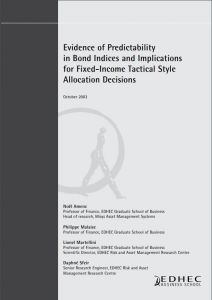

Evidence of Predictability in Bond Indices and Implications for Fixed-Income Tactical Style Allocation Decisions
There is now a consensus in empirical finance that expected asset returns, and also variances and covariances, are, to some extent, predictable. The use of predetermined variables to predict asset returns has produced new insights into asset pricing models, and the literature on optimal portfolio selection has recognized that these insights can be exploited to improve on existing policies based upon unconditional estimates. While the performance of tactical style allocation models is well documented in equity markets, very little evidence is available on the performance of systematic dynamic allocation decisions among various bond indices. This paper investigates the predictability of fixed-income style portfolio returns using a robust recursive modeling approach based on multi-factor models for the return on bond indices.
Author(s):
Summary:
There is now a consensus in empirical finance that expected asset returns, and also variances and covariances, are, to some extent, predictable. The use of predetermined variables to predict asset returns has produced new insights into asset pricing models, and the literature on optimal portfolio selection has recognized that these insights can be exploited to improve on existing policies based upon unconditional estimates. While the performance of tactical style allocation models is well documented in equity markets, very little evidence is available on the performance of systematic dynamic allocation decisions among various bond indices. This paper investigates the predictability of fixed-income style portfolio returns using a robust recursive modeling approach based on multi-factor models for the return on bond indices.
Register to download PDF
Register/Log in| Type : | Working paper |
|---|---|
| Date : | 10/01/2003 |
| Keywords : |
Tactical Allocation |

